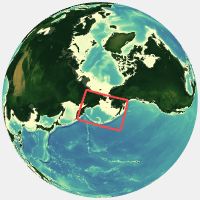Literature
This following academic publications describe the configuration and performance of the Bering10K ROMS model and its associated biological modules.
Danielson et al., 2011
The Bering Sea ROMS model was derived from the larger Northeast Pacific (NEP5) ROMS model. Much of the preliminary parameter configuration and validation of that model, including sea ice and tidal dynamics, are equally applicable to the Bering Sea sub-domain, and are documented here.
Danielson S, Curchitser E, Hedstrom K, Weingartner T, Stabeno P (2011) On ocean and sea ice modes of variability in the Bering Sea. J Geophys Res Ocean 116:1–24 link
Gibson & Spitz, 2011
This paper introduces the BESTNPZ biological model. The biological module is tested in a one-dimensional environment representative of the M2 mooring location, and a sensitivity analysis looks at the relationships between output variables and input parameters.
Gibson GA, Spitz YH (2011) Impacts of biological parameterization, initial conditions, and environmental forcing on parameter sensitivity and uncertainty in a marine ecosystem model for the Bering Sea. J Mar Syst 88:214–231 link
Hermann et al., 2013
The first paper detailing the Bering10K model in full, this includes a description of the ocean, sea ice, and biogeochemistry circa 2013; model validation focusing on tides, sea ice, circulation, and mixed layer dynamics); and a statistical analysis of covariability between output variables in a single long-term forecast (circa CMIP3).
Hermann AJ, Gibson GA, Bond NA, Curchitser EN, Hedstrom K, Cheng W, Wang M, Stabeno PJ, Eisner L, Cieciel KD (2013) A multivariate analysis of observed and modeled biophysical variability on the Bering Sea shelf: Multidecadal hindcasts (1970-2009) and forecasts (2010-2040). Deep Res Part II Top Stud Oceanogr 94:121–139 link
Hermann et al., 2016
This paper describes a series of long-term forecast simulations that downscale three CMIP3 (AR4) global circulation models under the A1B emissions scenario.
Hermann AJ, Curchitser EN, Hedstrom K, Cheng W, Bond NA, Wang M, Aydin K, Stabeno PJ, Cokelet ED, Gibson GA (2016) Projected future biophysical states of the Bering Sea. Deep Sea Res Part II Top Stud Oceanogr 134:30–47 link
Ortiz et al., 2016
This paper describes the results of a hindcast simulation with the Bering10K and BESTNPZ models fully coupled to a spatially-explicit fisheries ecosystem model known as FEAST.
Ortiz I, Aydin K, Hermann AJ, Gibson GA, Punt AE, Wiese FK, Eisner LB, Ferm N, Buckley TW, Moffitt EA, Ianelli JN, Murphy J, Dalton M, Cheng W, Wang M, Hedstrom K, Bond NA, Curchitser EN, Boyd C (2016) Climate to fish: Synthesizing field work, data and models in a 39-year retrospective analysis of seasonal processes on the eastern Bering Sea shelf and slope. Deep Res Part II Top Stud Oceanogr 134:390–412 link
Kearney et al., 2020
This paper describes an updated version of the BESTNPZ model, along with biophysical validation of the updated model (focusing on sea ice timing and extent, cold pool dynamics, macro- and micro-nutrient limitation, and primary production). It also includes a brief history of the changes that have been implemented in the biogeochemical, ocean, and sea ice portions of the model between the Hermann et al, 2013, Hermann et al., 2016, and Kearney et al., 2020 versions of the Bering10K-BESTNPZ model.
Kearney K, Hermann A, Cheng W, Ortiz I, Aydin K (2020) A coupled pelagic-benthic-sympagic biogeochemical model for the Bering Sea: documentation and validation of the BESTNPZ model (v2019.08.23) within a high-resolution regional ocean model. Geosci Model Dev 13:597–650 link
Kearney 2021
Many end users of the Bering10K model focus on its ability to simulate bottom temperature on the eastern Bering Sea shelf, and how the hindcast simulation compares to data collected annually across the shelf in support of fisheries management. This report provides a deep dive into the metrics use to compare these two datasets, with a focus on surface and bottom temperature.
Kearney K (2021). Temperature data from the eastern Bering Sea continental shelf bottom trawl survey as used for hydrodynamic model validation and comparison. U.S. Dep. Commer., NOAA Tech. Memo. NMFS-AFSC-415, 40 p. link.
Kearney et al., 2021
This paper tests the seasonal-to-sub-seasonal forecast capabilities of the Bering10K model with respect to seasonal sea ice cover and bottom temperature. These findings support the persistence forecast product that is presented each spring.
Kearney KA, Alexander M, Aydin K, Cheng W, Hermann AJ, Hervieux G, Ortiz I (2021) Seasonal predictability of sea ice and bottom temperature across the eastern Bering Sea shelf. J Geophys Res Ocean 126:1–21 link
